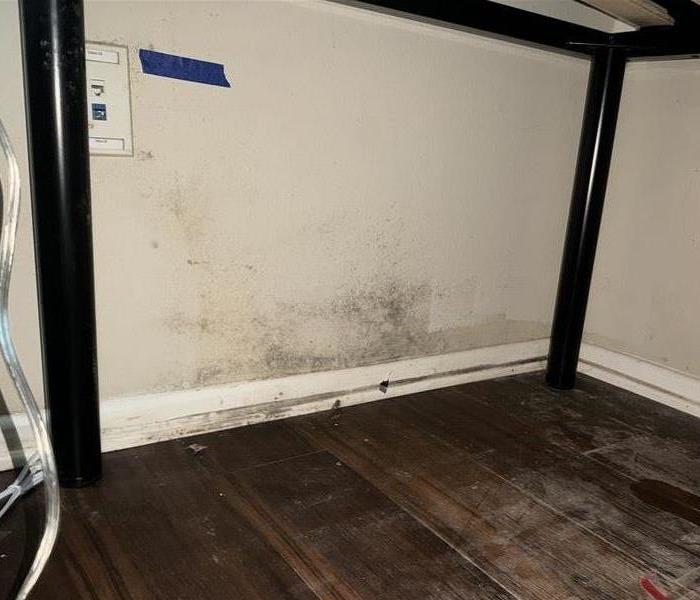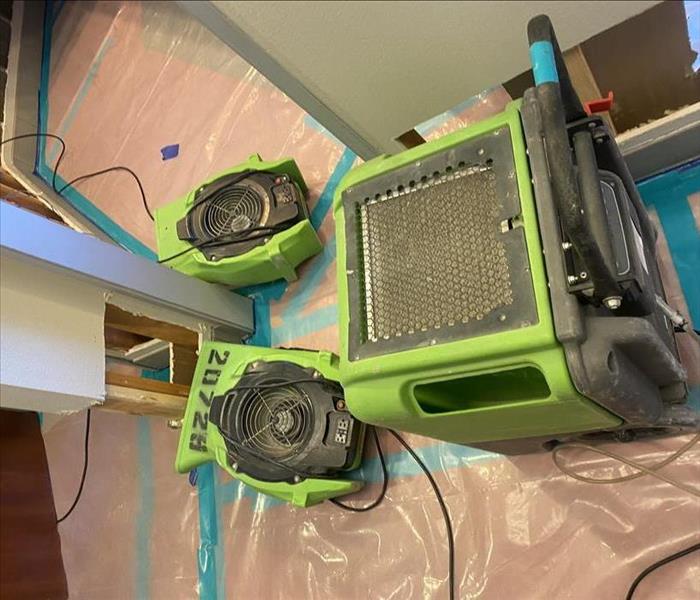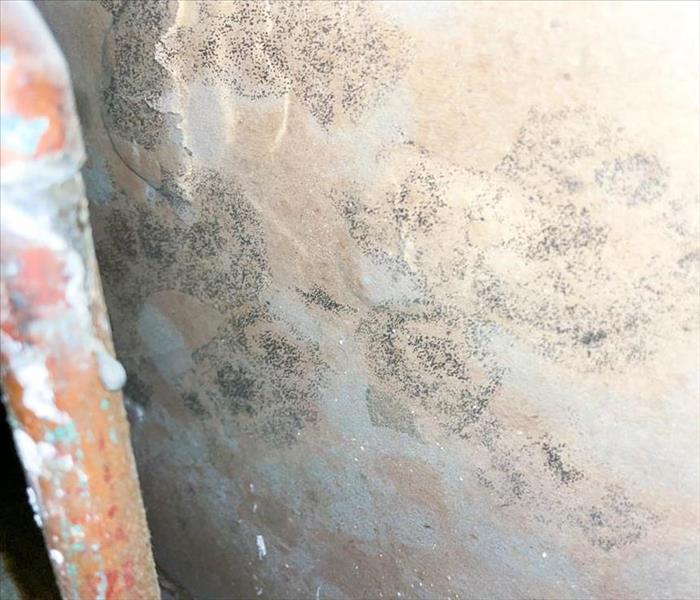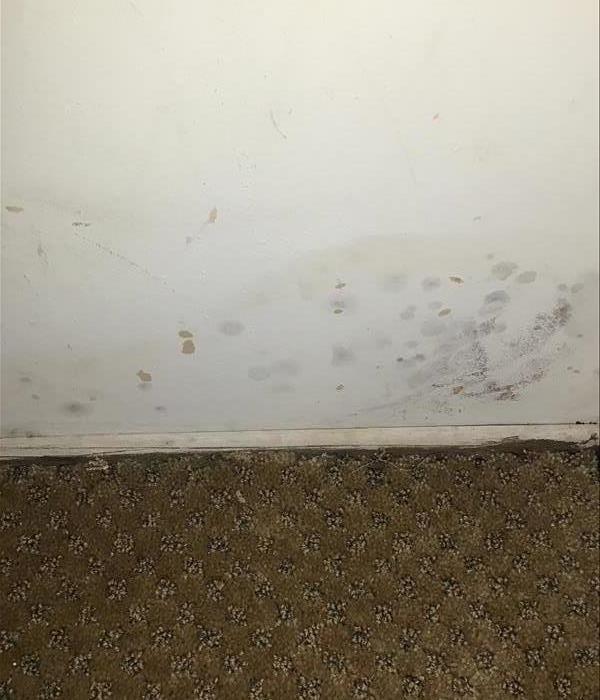Recent Mold Remediation Posts
Mold in Drywall: How to Identify and Repair with SERVPRO®
11/21/2024 (Permalink)
Mold in drywall can be a serious issue for homeowners. As a porous material, drywall readily absorbs moisture, making it an ideal breeding ground for mold when exposed to water. Whether it’s from a leak, flood, or high humidity, mold can quickly take hold, often going unnoticed until significant damage has occurred. Proper identification and repair of mold in drywall are crucial to preventing long-term structural issues and costly repairs. This blog will guide you through how to identify mold in drywall and the steps involved in repairing it, with expert assistance from SERVPRO®, your trusted mold remediation partner.
Identifying Mold in Drywall
Mold is not always easy to spot, especially when it’s growing behind walls or in less visible areas. However, certain signs can help you detect it early.
- Discoloration: Mold often causes dark spots or patches to appear on your drywall. These patches can be black, green, or brown and may start small before expanding.
- Musty Odor: Even if you don’t see mold, you might smell it. A musty odor in rooms with high moisture levels can indicate hidden mold behind walls or in areas that are difficult to see.
- Bubbling or Warping: When drywall becomes saturated with moisture, it may start to bubble, warp, or crack. This is a sign that water has penetrated the surface, and mold growth is likely behind or within the drywall.
- Peeling Paint: Paint that peels or flakes from the drywall can be another indication of moisture problems and potential mold growth.
If you notice any of these signs, it’s crucial to take immediate action. Mold can spread quickly, compromising both the aesthetic and structural integrity of your home.
Repairing Mold in Drywall
Once mold is identified, addressing it properly is essential to prevent further damage. Simply cleaning the surface isn’t enough when mold penetrates drywall, as the spores can easily regrow if moisture remains. Here’s a step-by-step outline for repairing mold-affected drywall:
1. Stop the Source of Moisture
Before any mold remediation can take place, it’s critical to address the underlying cause of moisture. Whether it’s a leaking roof, a plumbing issue, or excessive humidity, the source must be fixed to prevent future mold growth.
2. Remove Affected Drywall
In many cases, mold has penetrated the surface of the drywall, making it necessary to remove the affected sections. This may involve cutting away parts of the drywall to access and remove the contaminated material. SERVPRO’s trained professionals can assess the extent of the damage and safely remove the mold-affected drywall without spreading mold spores to other areas of your home.
3. Treat the Area for Mold
After removing the damaged drywall, the area must be thoroughly treated to kill any remaining mold spores. This involves using specialized cleaning agents and mold inhibitors to ensure that the mold does not return. SERVPRO uses advanced mold remediation techniques to eliminate mold spores and prevent future growth.
4. Replace and Refinish Drywall
Once the mold is removed and the area is treated, it’s time to replace the drywall. New sections are installed, sealed, and finished to match the surrounding wall. SERVPRO’s professionals ensure that the repaired area looks as good as new, restoring the appearance of your home.
Why Choose SERVPRO for Mold Remediation?
Mold remediation is a complex process that requires professional expertise, especially when it comes to drywall. SERVPRO of Laguna Beach offers comprehensive mold remediation services, using state-of-the-art equipment and techniques to identify, remove, and repair mold-damaged areas. With our team of experts, we ensure that the mold is completely removed and that your home is restored to a safe, mold-free environment.
Mold in drywall is a serious issue that requires prompt identification and repair. If you suspect mold in your home, acting quickly can prevent further damage and save you from costly repairs down the road. SERVPRO is your trusted partner for mold remediation and drywall repair, offering expert solutions to keep your home safe and sound. Don’t wait for mold to spread—contact SERVPRO today for professional mold removal and repair services.
Steps to Avoid Mold During Home Renovations
7/17/2024 (Permalink)
 By following these detailed steps, you can significantly reduce the risk of mold growth during your home renovations.
By following these detailed steps, you can significantly reduce the risk of mold growth during your home renovations.
Home renovations can breathe new life into your home but can also expose it to mold if moisture isn't controlled. Below are detailed steps to ensure your renovations are mold-free.
1. Identify Potential Problem Areas
Begin by thoroughly inspecting your home for any signs of existing mold or areas that are likely to develop mold, such as damp corners, basements, or under sinks. Look for discolored walls or ceilings which may indicate moisture problems. Addressing these issues before you start renovating can prevent mold from becoming a larger issue later.
2. Keep the Area Dry
Use dehumidifiers in the renovation area, especially if you're working in naturally damp places like basements. Cover the soil in crawlspaces with plastic sheeting to reduce humidity coming from the ground. Ensuring that the workspace remains dry is key in preventing mold growth, as mold spores thrive in moist environments.
3. Use Mold-Resistant Materials
Investing in mold-resistant materials can be crucial, especially in areas prone to moisture. Opt for mold-resistant drywall, which is treated to resist moisture and the growth of mold. Use paints and primers that contain mold inhibitors. These materials may cost more upfront but can prevent mold issues in the future, making them a worthwhile investment.
4. Seal Off Construction Areas
To prevent mold spores from spreading to other parts of the house, use heavy plastic sheeting to isolate the construction area. This not only helps in containing dust and debris but also minimizes the spread of mold spores that can be disturbed during construction.
5. Manage Water and Moisture
Be vigilant about water use in the construction area and be quick to clean up spills or leaks. If you discover any plumbing issues, address them promptly before proceeding with further renovations. It's important to ensure that all surfaces are dry before closing up walls, installing insulation, or laying flooring.
6. Properly Ventilate
Use fans to increase air circulation in the work area and open windows where possible to allow fresh air in and moisture out. Good ventilation is essential in reducing the humidity levels that mold spores need to grow.
7. Inspect and Clean HVAC Systems
Mold spores can easily spread through HVAC systems, which can distribute these spores throughout your home. Before and after renovations, have your HVAC system checked and cleaned to ensure it's not harboring any mold and is functioning efficiently to maintain good air quality.
8. Final Cleanup
After construction is complete, a thorough cleaning is necessary to remove any remaining dust and debris, which can harbor mold spores. Vacuum with a HEPA filter and wipe down all surfaces. It might be beneficial to hire professional cleaners to ensure that the area is meticulously cleaned.
By following these detailed steps, you can significantly reduce the risk of mold growth during your home renovations. Proactive moisture management, using appropriate materials, and keeping things clean will help keep your newly renovated space both beautiful and mold-free. If you have concerns about mold or need assistance with mold prevention, don't hesitate to contact our SERVPRO of Laguna Beach team today!
Safe Mold Cleaning Products for Your Home
3/13/2024 (Permalink)
 In this blog, we will explore safe mold cleaning products that are OSHA and EPA-approved and can be used in the home.
In this blog, we will explore safe mold cleaning products that are OSHA and EPA-approved and can be used in the home.
Mold is a common problem in many homes, especially in damp or poorly ventilated areas. Mold can spread quickly and pose potential risks to your home. Cleaning up mold in your home is essential to maintain a safe living environment. However, selecting the right cleaning products is crucial, as not all products are created equal. In this blog, we will explore safe mold cleaning products that are OSHA and EPA-approved and can be used in the home.
Understanding OSHA and EPA-Approved Mold Cleaning Products
OSHA Approved Products: The Occupational Safety and Health Administration (OSHA) gives guidelines for using cleaning products safely and effectively. OSHA-approved mold cleaning products are specifically designed to combat mold and are certified to ensure safe use for humans and the environment. These products contain specific ingredients, such as sodium hypochlorite and hydrogen peroxide, that have antimicrobial properties, killing mold and other harmful bacteria effectively.
EPA-Approved Products: The Environmental Protection Agency (EPA) provides a label certification program for mold cleaning products to ensure they are safe for use. EPA-approved products undergo rigorous testing to ensure they are effective and free of harmful ingredients. These products often come in the form of "Green" options that promote a more sustainable and eco-friendly approach.
Safe Mold Cleaning Products for Your Home
Bleach: Bleach is a common household disinfectant and is also effective at killing mold. The active ingredient in bleach, sodium hypochlorite, effectively targets and kills mold spores. However, bleach can cause health problems when misused and can also damage surfaces, especially porous materials. Ensure proper ventilation and follow safety instructions when using bleach for mold cleaning.
Hydrogen Peroxide: Hydrogen peroxide is a safer alternative to bleach for mold cleaning. It is non-toxic and does not emit harmful fumes. Hydrogen peroxide breaks down into oxygen and water, leaving no harmful residue. It effectively kills mold spores and is safe for use on various surfaces, including wood, fabric, and carpets.
Vinegar: Vinegar is another non-toxic and natural mold-cleaning solution. Its acidic nature effectively kills mold spores and is safer for kids and pets. However, vinegar may not be as effective at killing all types of mold, and its strong odor may be off-putting to some.
EPA-Approved "Green" Products: For a more sustainable and environmentally friendly approach, consider EPA-approved "Green" mold cleaning products. These products are made with natural ingredients and are safer and less harmful than traditional cleaning products. They are also effective at killing and preventing future mold growth.
Mold cleaning is an essential task for maintaining a safe home environment. However, choosing the right cleaning products is crucial for both safety and effectiveness. OSHA and EPA-approved mold cleaning products are the best options for safe and efficient mold remediation. Bleach, hydrogen peroxide, and vinegar are some of the commonly used household products that you can consider for mold cleaning. Additionally, eco-conscious consumers can opt for "Green" mold cleaning products that promote a sustainable and safer approach to cleaning. Remember to always follow instructions and safety precautions when using any cleaning products.
Mold and Moisture Control in Commercial Buildings
11/14/2023 (Permalink)
 Mold is a common problem in commercial buildings, and it thrives in damp, humid conditions.
Mold is a common problem in commercial buildings, and it thrives in damp, humid conditions.
Commercial property owners and managers face unique challenges when it comes to maintaining their buildings. Mold and moisture issues can be particularly troublesome in this area due to its coastal climate. In this blog, we'll discuss the importance of mold and moisture control in commercial buildings and provide valuable tips to help you protect your investment and maintain a safe environment for occupants.
Understanding Mold and Moisture Issues
Mold is a common problem in commercial buildings, and it thrives in damp, humid conditions. Mold can cause serious structural damage, leading to expensive repairs.
Preventive Measures
- Regular Inspections: Perform routine inspections to identify any water leaks, plumbing issues, or signs of moisture intrusion. Promptly address these issues to prevent mold growth.
- Proper Ventilation: Ensure that your building has adequate ventilation to reduce humidity levels. Install exhaust fans and consider dehumidifiers in areas prone to moisture buildup.
- Roof Maintenance: Check and maintain your roof regularly to prevent leaks. Leaking roofs can allow moisture to seep into your building, creating an ideal environment for mold.
- Drainage Management: Ensure proper drainage systems are in place, and gutters are clean and functioning correctly. This will help divert rainwater away from the building.
- Seal Windows and Doors: Properly seal windows and doors to prevent water infiltration during heavy rains or storms.
- Proactive Repairs: Address any water damage or leaks promptly to prevent mold growth. Mold can start to develop in as little as 24-48 hours.
Mold Remediation
If you do encounter mold in your commercial building, it's crucial to address it immediately. Mold can cause serious property damage and can spread rapidly. SERVPRO® offers professional mold remediation services in Laguna Beach, and can help you:
- Assess and Identify: Our experts will assess the extent of the mold problem and identify the type of mold present.
- Containment: We will establish containment barriers to prevent further mold spore spread during remediation.
- Safe Removal: Our technicians will safely remove and dispose of the mold-infested materials.
- Drying and Dehumidification: We'll dry the affected areas and use dehumidifiers to prevent mold from returning.
- Cleanup and Restoration: Once mold is removed, we will clean and restore the affected areas to their pre-mold condition.
Preventive Maintenance Plans
SERVPRO® of Laguna Beach/Dana Point/Aliso Viejo offers preventive maintenance plans to help commercial property owners stay ahead of mold and moisture issues. Regularly scheduled inspections, maintenance, and moisture control can save you time and money in the long run.
Protecting your commercial building from mold and moisture issues is essential for maintaining a safe and welcoming environment for your occupants. With the right preventive measures and prompt action, you can avoid costly repairs. If you do encounter mold problems, don't hesitate to contact our SERVPRO® team for professional assistance. We're here to help you keep your property clean, safe, and mold-free!
Understanding the Importance of Mold Remediation: A Guide to the Process
5/9/2023 (Permalink)
 Mold remediation is an important process for removing and preventing future mold growth.
Mold remediation is an important process for removing and preventing future mold growth.
Mold is a type of fungus that can grow in damp and humid environments. If you suspect that you have mold in your home or business, it's important to address the problem quickly to prevent further damage and potential health risks. This is where mold remediation comes in.
Mold remediation is the process of removing mold from a building and preventing its future growth. This involves identifying the type and extent of the mold problem, containing the affected area, removing the mold, and taking steps to prevent it from returning. Here's a breakdown of the mold remediation process.
Assessment
The first step in the mold remediation process is to conduct an assessment of the affected area. This involves visually inspecting the area for mold growth and determining the extent of the problem. A professional mold inspector may also take air and surface samples to determine the type of mold present.
Containment
Once the extent of the mold problem has been determined, the next step is to contain the affected area to prevent the spread of mold spores to other parts of the building. This may involve using plastic sheeting to seal off the area, as well as negative air pressure to ensure that mold spores do not escape.
Removal
The mold must then be removed from the affected area. This typically involves physically removing any visible mold growth and using specialized cleaning agents to kill any remaining mold spores. In some cases, it may be necessary to remove and replace contaminated building materials such as drywall or insulation.
Drying
After the mold has been removed, the affected area must be thoroughly dried to prevent future mold growth. This may involve using dehumidifiers or fans to dry the area and reduce humidity levels. This may involve repairing any leaks or moisture problems that contributed to the mold growth, improving ventilation, and using mold-resistant building materials.
It's important to note that mold remediation is not a one-size-fits-all solution. The process may vary depending on the type and extent of the mold problem, as well as the building materials and environment involved. It's also important to work with a qualified mold remediation professional who has the expertise and equipment needed to properly address the problem.
In conclusion, mold remediation is an important process for removing mold and preventing its future growth. If you suspect that you have a mold problem, it's important to address it quickly to prevent potential secondary damage and further damage to your home or building. SERVPRO® has the experience and knowledge to return your home to its original state and prevent mold from potentially returning to your home.





 24/7 Emergency Service
24/7 Emergency Service
